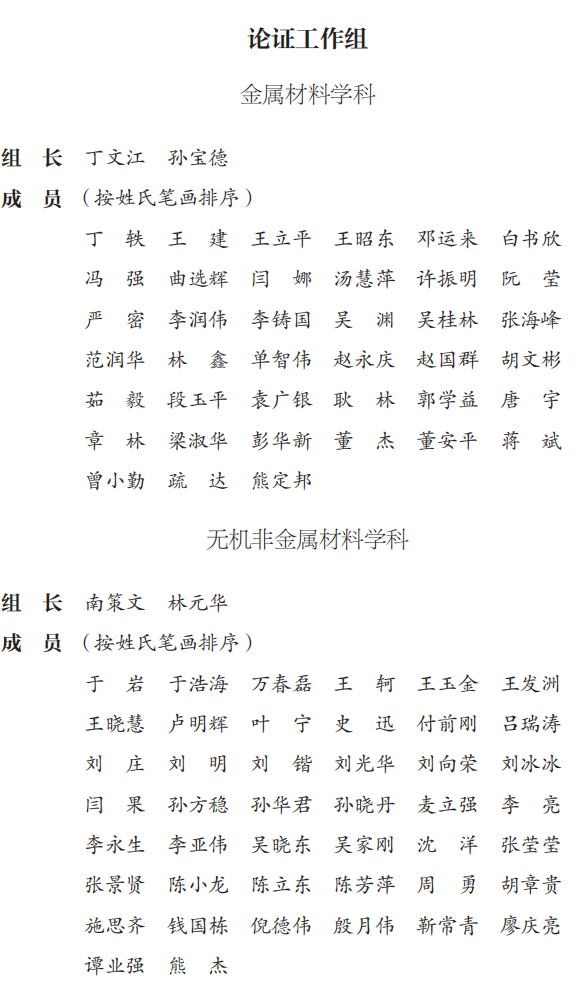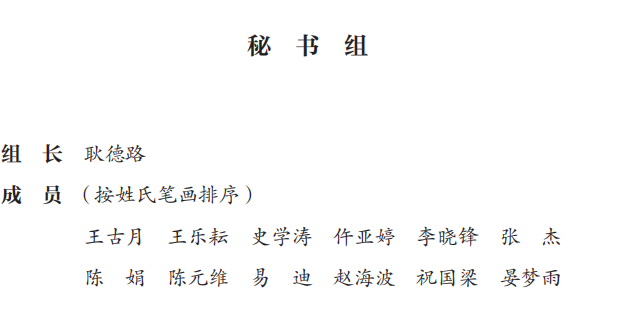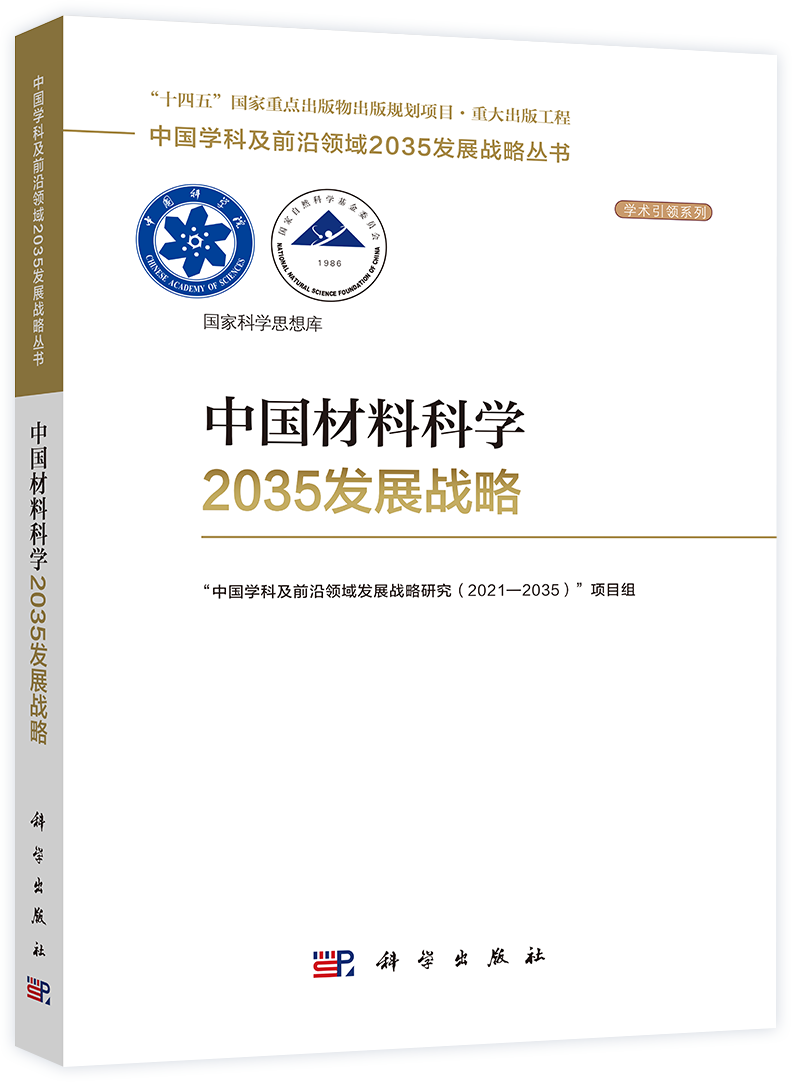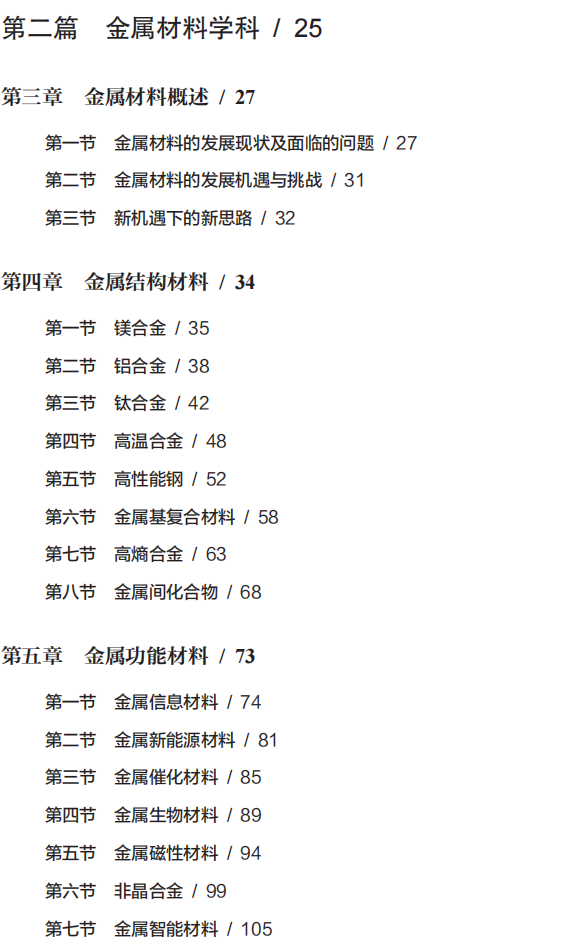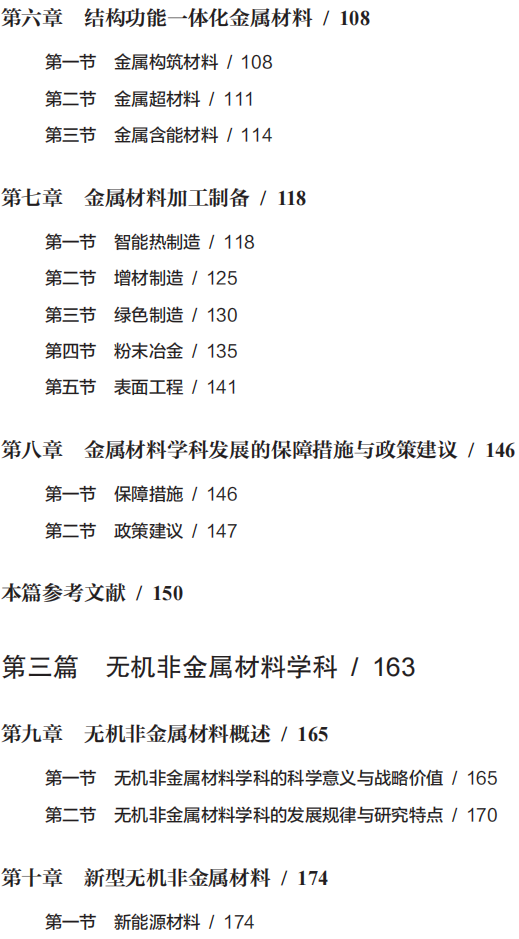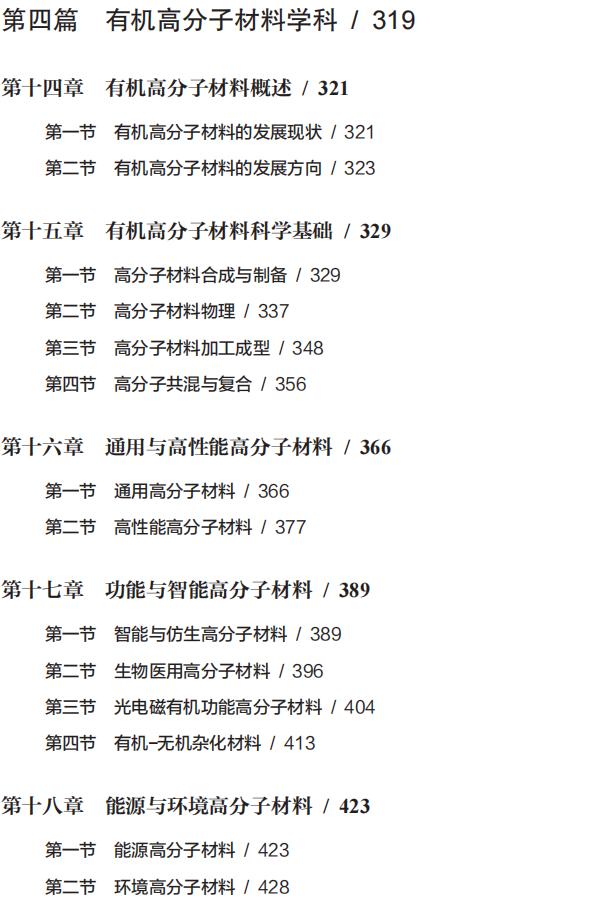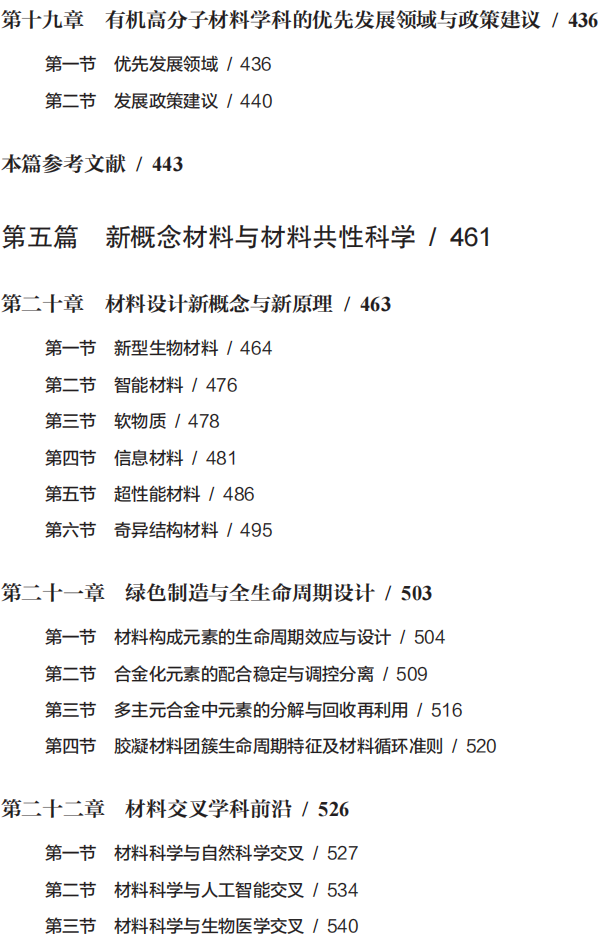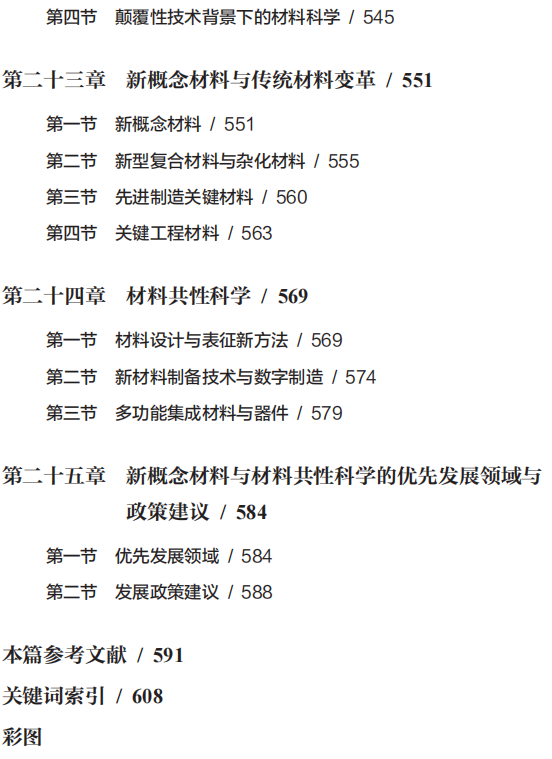一、材料科学的战略地位和科学意义
材料是支撑世界高新技术和现代工业经济不断发展的必需物质基础。一代材料承载一代技术,形成一个时代标志。钢铁是第一次科技革命中发明蒸汽机的必要条件。第二次科技革命实现电气化离不开有色金属材料。半导体电子材料制约着第三次科技革命中计算机技术的更新换代。新型能源材料和纳米材料加速了第四次科技革命的演变进程。象征第五次科技革命的互联网技术的出现也强烈依赖于高性能信息材料和智能材料体系。展望未来,生物医用材料将在第六次科技革命中发挥举足轻重的作用。因此,我国早就将材料科技工业列为国家战略性新兴产业。
材料科学与物质科学密切相关,但是二者的研究内容和科学目标各有侧重,并且具有明确的学科划分界面。材料是在人类生产和生活过程中已经实际应用或者显示潜在用途的各类物质。狭义地理解,物质科学是物理学、化学、生物学、天文学和地学等自然科学领域的一个重要学科。材料科学的核心导向是系统研究可以成为“器材原料”的各类物质的科学属性和应用特征,属于工程和技术科学的范畴,是一个典型的应用基础研究学科。可以认为,材料科学是自然科学与工程技术的交叉学科,与冶金、化工和机械工程等学科共同奠定了新型工业体系发展的科学基础。
二、材料科学的研究特点与发展规律
材料科学作为一个完整独立的学科体系成形于20世纪80年代,此前相关研究零散分布于冶金学、物理学、化学化工、机械工程及生物医学等科技领域。按照材料的化学组成,其研究对象主要包括金属材料、无机非金属材料和有机高分子材料等三大类型。材料科学的研究过程从物理学和化学关于物质结构与性质理论出发,采用现代数学和计算技术作为分析工具,以实验研究为基础且面向材料工程应用,主要探索各类材料的微观结构与优化设计、合成制备与成形加工,以及服役性能与循环利用。
材料学科的发展驱动力来自三个方面:首先是高科技领域对千姿百态的特种新材料的战略需求牵引;其次是材料科学前沿生长点和新兴交叉方向的萌生与蓬勃发展;最后是纯粹自然科学和智能信息技术等相关领域的重大科技突破不断提供催化和助推效应。
未来,材料学科的发展趋势将呈现六大特征:①材料科学与物质科学的交叉融合更加广泛深入;②材料科学与信息技术、人工智能和生物医学领域相互促进;③航空、航天、航海、核工业、生物医学等尖端需求给新材料带来挑战和机遇;④全新的时空概念冲击着材料科学的前沿生长点;⑤“双碳”(碳达峰、碳中和)时代强化材料绿色制造和全寿命循环利用研究;⑥高等教育的新发展促进材料学科体系的变革和重构。
三、材料科学的关键问题及发展思路
在国家自然科学基金委员会和有关部委的共同支持下,我国材料学科取得了长足发展。特别是,21世纪以来我国材料学科研究队伍规模和发表论文数量均跃居世界首位。然而,我国材料学科的原始创新能力远没达到引领国际材料科技前沿的水平。未来实现材料学科的更好发展亟待解决六个关键科学问题:一是面向世界科技前沿,策划材料科学的未来发展架构;二是面向国家重大战略需求,设计材料科学的未来重点发展方向;三是着眼全新时空背景,强化材料科学与人工智能和生物医学领域交叉融合;四是基于“双碳”目标和保护环境基本国策,贯彻材料绿色制造与全寿命控制理念;五是服务经济建设主战场,倡导材料科学—材料技术—材料工程三维融合研究;六是突破“五唯”束缚,实现从跟踪向引领材料科技前沿的根本转变。
根据两年的广泛调研和深入论证,材料学科的未来发展思路应该是:立足国家经济社会发展需求,瞄准世界材料科学与技术前沿,积极融入和促进第六次科技革命,统筹布局符合我国国情的优先发展研究方向,在追赶超越过程中逐步重构材料科学新体系。经过15 年的努力,预期实现以新材料、新技术、新理论、新体系为特征的“四新”发展目标:①基础理论研究指引新材料设计,建立中国原创的高性能新材料谱系;②加强科学研究的技术化导向,建立战略性传统材料的变革性新技术系统;③追求切实可行的重点科学目标,力争智能材料、生物材料和纳米能源材料等热点领域的多方面理论突破;④基于材料科学与技术的前沿进展,建立以新概念材料和交叉共性科学为先导的“北极星型”材料学科新体系;⑤面向国民经济主战场的重大战略需求,建立先进结构材料国家实验室和新型功能智能材料国家实验室,形成材料领域的国家战略科技力量。
四、材料科学的发展策略与政策建议
(一)重点发展方向
1. 金属材料学科
在材料科学的四个分支学科中,金属材料学科重点发展方向包括:金属结构材料的强韧化新原理、新方法研究;金属功能材料的原子层次结构与性能调控机制研究;金属材料制备与加工过程的变革性理论方法和全新技术装备设计原理研究。
2. 无机非金属材料学科
无机非金属材料学科重点发展方向包括:“双碳”目标牵引的新能源材料研究;满足国防科技和高端制造需求的高性能结构材料研究;满足电子信息与人工智能迫切需求的半导体晶体和功能陶瓷材料研究;面向人民生命健康的生物医用和环境治理材料研究。
3. 有机高分子材料学科
有机高分子材料学科重点发展方向包括:先进复合材料、新型智能材料、高性能生物和信息材料;探索建立“双能化—复合化—智能化—精细化—绿色化”五维归一的材料科学研究新范式。
4. 新概念材料与材料共性科学
新概念材料与材料共性科学是国家自然科学基金委员会于2019 年新设立的第四个材料分支学科,其未来重点发展方向包括:新奇特材料的设计合成和结构性能研究;面向人工智能的多功能材料与材料基因调控研究;材料绿色制造和全寿命循环利用优化控制过程研究;航空、航天、能源、交通等战略领域赖以发展的新型核心材料研究。
(二)优先发展领域
1. 金属材料学科
金属材料学科优先发展领域包括:轻质高强金属材料;高温合金和轴承钢等特殊黑色金属;信息、能源和生物医药金属功能材料;材料制备与加工新工艺;材料加工高端装备。
2. 无机非金属材料学科
无机非金属材料学科优先发展领域包括:面向“双碳”目标的新能源材料;高性能结构材料;功能晶体及陶瓷;先进碳材料;量子材料。
3. 有机高分子材料学科
有机高分子材料学科优先发展领域包括:通用高分子材料高性能化和功能化的方法与理论;智能与仿生高分子材料的新概念设计原理和制备方法;目标导向的生物医用高分子材料的基础研究与应用评价方法;能源与环境高分子材料;特定服役条件下的先进高分子材料。
4. 新概念材料与材料共性科学
新概念材料与材料共性科学优先发展领域包括:未来材料的人工设计与构筑成型研究;特殊环境下材料设计与表征方法研究;材料多功能耦合与集成新原理和新机制研究;国家战略性特种材料谱系设计与传统材料变革性研究。
(三)重大交叉领域
1. 金属材料学科
金属材料学科重大交叉领域包括:金属材料加工制备的数字化与智能化理论与技术;金属材料与能源、信息和生命学科的交叉研究;金属材料与物理及化学学科的交叉研究,特别关注金属力学和物理化学性能的电子理论,即把对金属材料性能的理解从原子层面深入到更加微观的层面。
2. 无机非金属材料学科
无机非金属材料学科重大交叉领域包括:信息功能材料及器件;生物医用材料;无机非金属材料研究新范式。
3. 有机高分子材料学科
有机高分子材料学科重大交叉领域包括:有机/无机复合半导体材料和信息材料;智能与多功能高分子复合材料;先进功能有机膜材料;材料多层次多尺度复合新方法与新原理。
4. 新概念材料与材料共性科学
新概念材料与材料共性科学重大交叉领域包括:全新时空背景下材料设计制备、成型过程与服役特性研究;基于人工智能的新型材料组织性能优化调控研究;“双碳”时代传统支柱材料的绿色再生机制研究;面向临床医学的新型生物医用材料设计与合成研究。
Abstract
During the first two decades of this century, materials science has made great progress in many respects and brought various novel or advanced materials for the world’s industry, especially high technology felds. At the begining of 2020, the National Natural Science Foundation of China (NSFC) and the Chinese Academy of Sciences (CAS) jointly sponsored a strategic research project about the development trends of materials science in the medium future until 2035. More than 410 distinguished materials scientists from Chinese universities, research institutes have contributed actively to this advisory study. The present book summarizes the main ideas and expectations as the four aspects below.
. The strategic position and scientific significance of materials science
Materials are the essential foundation to support the continuous
development of the world’s new high technology and modern industrial economy. Anew generation of materials carries an innovative generation of technologies and represents the landmark of a new era. Iron and steel is the prerequisite to inventing steam engines which initiated the first technological revolution. Nonferrous metallic materials played a dominant role in realizing the electrifcation of human life and production during the second technological revolution. Semiconductors and other electronic materials acted as the key factor in innovating computer technologies for the third technological revolution. Novel energy materials and nanostructure materials promoted the evolution process for the fourth technological revolution. The emergence and implementation of internet technology, which was a characteristic of the ffth technological revolution, also relied heavily on the systems of advanced information materials and smart materials. In the future, biomedical materials will display their decisive in?uences on the forthcoming sixth technological revolution. Therefore, China has already classified materials science and technology industry as one of its newly thriving enterprises for state development strategy.
Materials science is closely related to matter science. But these two disciplines diferentiate from each other by apparent boundaries in both preferential research contents and scientific objectives. Materials are those partial types of substances that either have already found practical applications in human production and life processes or exhibited obvious application potential. From a narrow-minded understanding, matter science is an important branch of natural sciences correlated with physics, chemistry, biology, astronomy and geology, whereas materials science belongs to the regime of engineering and technical sciences. This typically applied science discipline directs its research purposes toward the systematic investigations about the scientific nature and applied performances of useful matters, which may become the raw materials or constitutional parts to manufacture various objects and products. It may be regarded as an interdisciplinary field between natural sciences and engineering sciences. In fact, the combination of materials science with metallurgy, chemical engineering and mechanical engineering has laid the scientifc basis for modern industrial systems.
. Research methodology and evolution features of materials science
The main frame of materials science was formed as an independent and integrated science discipline in the 1980s. In earlier times, diverse materials research had been scattered among the relevant scientific felds such as metallurgy, physics, chemistry and chemical engineering, mechanical engineering, as well as biomedicine. According to the chemical constitutions of materials, there are mainly three types of materials as the research objects of this discipline: metallic materials, inorganic nonmetallic materials, and organic polymer materials. The research process of materials science originates from the physical and chemical theories about the structure and property of matter. Modern mathematics and computing techniques provide powerful analytical tools for materials research. Experimental investigations represent the keynote of materials science, which always aims at engineering applications. The prime tasks of materials science include microstructural characterization, optimized design, synthesis and preparation, deforming and processing, applied performances and cyclical applications for different kinds of materials.
The driving force to develop materials science comes from three respects. At first, the ever-increasing demands for diverse kinds of special new materials in high technology felds stimulate a great dragging effect. Secondly, the cultivation of new growth frontiers and thriving interdisciplinary directions boosts the spontaneous advancement of materials science. Thirdly, the signifcant breakthroughs of related felds such as pure natural sciences and intelligent information technology continually bring in catalytic and supportive forces.
In the coming years, materials science will display six developing trends:①it interacts with matter science to a more intensive extent;②it correlates extensively with such frontier felds as information technology, artifcial intelligence and biomedicine;③it accelerates its development to meet the challenge and opportunity raised by the requirements from those strategic fields including aerospace, navigation, nuclear industry, biomedicine;④it modifies its cutting edges under the impacts of disruptive concepts emerging from an era of the new time and space ideology;⑤it further emphasizes the green manufacturing of materials and whole-life cyclical applications in the age of “double carbon” (carbon peak and carbon neutrality); and⑥the most recent progress of college education facilitates the revolutionary advancement and even reconstruction of the materials science system.
. Discipline frontiers and development ideology for materials science
Owing to the continuous support of NSFC and other governmental departments, China’s materials science discipline has made significant achievements. In particular, both the magnitude of research teams and the number of published papers have attained the first place in the world. Nevertheless, there still exists a rather large gap between our actual creativity to accomplish original studies and the expected role of guiding the international trends of materials science and technology. In order to secure better future development, the following six issues have to be solved properly. Firstly, the future development scheme of materials science should be contrived with the mind to face the world’s frontiers of science and technology. Secondly, the key development directions should be plotted to confront the national strategic demands. Thirdly, the intercrossing and merging of materials science with artifcial intelligence and biomedicine felds should be encouraged efectively in the background of new time and space concepts. Fourthly, the conception of green manufacturing of materials and whole-life control ought to be implemented to follow the national “double carbon” and environmental protection policies. Fifthly, the triple comprehensive investigations to merge materials science with materials technology and materials engineering may be promoted to serve the main fields of economic construction. At last, a thorough transition from follow-up work into original research at the frontiers of materials science and technology must be driven by the establishment of a more objective evaluation system for scientifc explorations.
On the basis of two years’ extensive survey and systematic demonstration, the prospective guidelines for future development have been drawn up. In a word, materials science should keep the primary standpoint to meet the needs of the national economy and society advancements, focus on the world’s frontiers of materials science and technology, promote and merge with the probably coming sixth technological revolution, make a comprehensive arrangement for the preferential research directions suitable for China, and gradually reconstruct a novel framework for materials science in the process of pursuing and overtaking research fronts. The following four development goals characterized by “new materials–new technology–new theory–new system” will be fulfilled through fifteen years of effort.①To establish China’s own creative spectrum system of new high performance materials through the novel material design guided by fundamental research.②To build up the innovative technology system for strategic traditional materials by reinforcing the technical transition of scientific research.③To strive for multiple theoretical breakthroughs in such hot fields as intelligent materials, biological materials and nanoenergy materials through pursuing key scientific fronts with practical achievability.④To set up a “Polaris Pattern” disciplinary frame with new concept materials and materials common science acting as the leading polar tip according to the frontier advances of materials science and technology.⑤To establish two national laboratories for advanced structural materials and new functional materials respectively, which will provide e?cient services to meet the strategic demands of main economic battlefeld and represent the national strategic force of materials science and technology.
. Development strategy and policy recommendations for materials science
There is no doubt that materials science will meet greater challenges and achieve better prosperity in the coming fifteen to thirty years. As the fnal summary of the state-of-the-art analyses presented above, three respects of proposals are made for the development tactics of materials science, which are concisely described below.
1. Key development directions
Among the four branches of materials science, the metallic materials discipline emphasizes the research about the new principles and approaches to strengthen and toughen structural materials; the atomistic structure analyses and property modulation mechanisms of functional materials; the innovative theories and methods of preparation and processing, and the design principles for completely new technology and equipment.
The inorganic nonmetallic materials discipline lays the research stress upon the new energy materials for “double carbon” purposes; the high performance structural materials demanded by the national defense and advanced manufacture felds; the semiconductor crystals and functional ceramic materials urged by electronic information science and artifcial intelligence technology; the biomedical materials to serve human life and health, and the catalytic and refining materials for environmental protection.
The organic polymer materials discipline takes the keynote study of advanced composite materials, new smart materials, high performance biological and informative materials; new paradigm of materials science research unifying the quinary factors to simultaneously realize “double functions–composite–intelligence–refning–green processing”.
The fourth discipline of “new concept materials and materials common science” was newly founded by NSFC in 2019. Its key research directions lie in the design and synthesis as well as the structure and property of new or strange or special materials; the multifunctional materials and materials genome modulation correlated with artificial intelligence technology; the green manufacture of materials, the optimized control process of whole-life cyclic applications for materials; the new types of kernel materials requested by those strategic fields involving aerospace industry, power plants and advanced communication technologies.
2. Priority development areas
The metallic materials discipline chooses the preferential research upon the light and strong metallic materials; the special ferrous alloys such as superalloy and bearing steel; the metallic functional materials for information science, energy technology and biomedicine; the new principles and technology of materials preparation and processing; and the novel design of experimental apparatuses and processing equipment for materials research.
The inorganic nonmetallic materials discipline places the research priority on the new energy materials for “double carbon” goals, high performance structural materials, functional crystals and ceramics, advanced carbon materials; and quantum materials.
The organic polymer materials discipline sets the research preference at the theory and methodology to enhance the performances and functions of general polymer materials, the new conception design principles and preparation methods for intelligent and bionic polymer materials, the fundamental study and application evaluation methods of biomedical polymer materials for targeting treatment, the polymer materials for energy technology and environmental protection, and the advanced polymer materials for special service conditions.
The new concept materials and materials common science discipline stresses the preferred research about the artificial design and pattern architecture of future materials, the material design and characterization methods for extraordinary environments the new principles and mechanisms to couple and integrate the multiple functions of materials, the spectrum design of special strategic materials and the innovative exploration of kernel traditional materials.
3. Essential interdisciplinary areas
The metallic materials discipline supports the essential intercrossing research areas about the theory and technology of digitized and intellectualized metallic materials preparation and processing; intercrossing studies of metallic materials correlated with energy, information and life science; and the interpenetration with physical and chemical investigations, paying special attention to the electronic theory about the mechanical and physicochemical properties of metals and alloys, so that structural analyses can develop from the atomistic level into more microscopic scale.
The inorganic nonmetallic materials discipline encourages intercrossing studies such as the functional materials and devices for information science, the biomedical materials for life science and human health, and the novel research format to innovate inorganic nonmetallic materials.
The organic polymer materials discipline emphasizes those intercrossing research subjects including the organic/inorganic composite semiconducting materials and information materials, the smart and multifunctional polymer composites, advanced functional organic film materials, and the new principles and methods to produce multilevel and multiscale composites.
The new concept materials and materials common science discipline concentrates the intercrossing research areas upon the material design and synthesis, deformation and processing, as well as structure modulation and applied performances in the backgrounds of new time and space conception; the optimized regulation of new material structure and property based on artificial intelligence; the green cyclic reproduction mechanisms of traditional pillar materials in the age of “double carbon” policy for environmental protection; and fnally the innovative design and synthesis of new biomedical materials for clinical applications.

